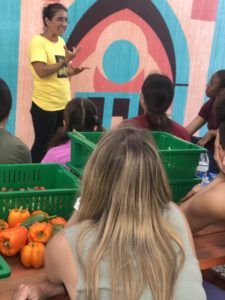THRIVE Innovation District
THRIVE Innovation District
Opa-Locka Community Development Corporation (CDC) is an experienced real estate developer. It produces and manages affordable housing, builds and refurbishes commercial spaces, and provides family services, financial empowerment and small business assistance. And, in the words of Opa-Locka CDC Director of Partnership Engagement Karla Gottlieb, “We are all about art.” Art is a common thread…
Location
Opa-Locka, Florida
Partners
Opa-Locka Community Development Corporation
Public Funding Includes
Miami-Dade County: Grants from the county’s allocation of U.S. Department of Housing and Urban Development Community Development Block Grant (CDBG) funds
U.S. Department of Housing and Urban Development: Housing Counseling
U.S. Department of Health and Human Services: Office of Community Services
Low-Income Housing Tax Credits
National Endowment for the Arts: Art Works
U.S. Department of Housing and Urban Development: Choice Neighborhoods Planning Grant
Opa-Locka Community Development Corporation (CDC) is an experienced real estate developer. It produces and manages affordable housing, builds and refurbishes commercial spaces, and provides family services, financial empowerment and small business assistance. And, in the words of Opa-Locka CDC Director of Partnership Engagement Karla Gottlieb, “We are all about art.” Art is a common thread throughout its work, including renovation of the city’s historic Moorish Revival–style train station, support for public art and performances, and the development of new affordable housing that incorporates artistic elements. The organization’s THRIVE Innovation District in downtown Opa-Locka brings the many strands of its work together with a placemaking effort that includes an arts charter school, an arts and recreation center, an urban farm and commercial kitchen, and a technology center.

Photos courtesy of Opa-Locka Community Development Corporation
Opa-Locka CDC relies heavily on federal funding from the U.S. Department of Housing and Urban Development and the Department of Health and Human Services to support its housing development and programs. The organization long ago built the infrastructure to apply for and manage federal funding. The group has been successful year after year in applying for suballocations of Miami-Dade County CDBG funds, a track record Gottlieb attributes to both the trusting relationships it has built at the county level and its ability to write compelling applications. Throughout the organization, Opa-Locka CDC has staffed its team with savvy professionals who understand government funding and are able to deliver results. “For 30 years, federal grants were all that we did,” Gottlieb said. “Real estate and housing continue to be the foundation of our work and that often requires federal funding” due to the scope and scale of projects and the need for subsidy to keep housing affordable. In the last 10 years, Opa-Locka CDC has started to explore private and foundation grants, but public funding has been the driver of its success.

Photos courtesy of Opa-Locka Community Development Corporation
That does not mean it is easy, however. “An area that is really hard for all agencies is the financial side of it,” according to Gottlieb. “The tracking of the federal funds, the executing of the reports.… I feel like our finance department could be three times its size and they still would be overwhelmed.” She added that meeting the compliance and reporting requirements of federal grants is very time consuming. To manage the burden, Opa-Locka CDC Chief Operating Officer Nikisha Williams said they look for the right grant fit: “There are so many grants out there, you can get grant-writing fatigue. One of the things we are trying to do is be very thoughtful about the grants we apply for. Does it fall in line with what we want to do versus are we following the direction of the grant? Do we have suitable experience? Do we need or are we able to bring on a partner?” Because Opa-Locka CDC’s prowess is in real estate, it continues to apply for and win grants to support that activity. It is more careful with its approach to other types of grants, but above all, Williams and Gottlieb try to ensure the opportunity fits in with the work the organization is doing, instead of trying to alter their vision to make themselves eligible for a grant that may not prove to be a good fit.
Federal funding comes with other limitations as well. It can support housing developments that include artistic elements, but developers do have to get creative in funding the art itself. Working with complementary organizations can help. “I think that partnership is probably key for organizations looking to get into [the federal grant] space,” said Williams. “As arts organizations, we probably need to band together. I do think arts organizations should be reaching out to CDCs and other organizations that do what they don’t do and seeing how they can work together.” But Gottlieb cautions that organizations should make sure the partnership and the opportunity is worth their while and seek bigger pots of funding: “You can’t do anything when you’re splitting $50,000 four ways.”

Photos courtesy of Opa-Locka Community Development Corporation
Williams said she thinks her organization’s ability to weave art and other programming into their work – alone or with the help of partners – is an asset. “I think we have been successful in the last 10 years because the applications we submit are rarely singularly focused. We always incorporate some other part of our organization, whether it’s workforce, housing, real estate, youth or art. We have the luxury of touching all these different areas. If you are a smaller organization that doesn’t have all these areas, partnership is so important.”

